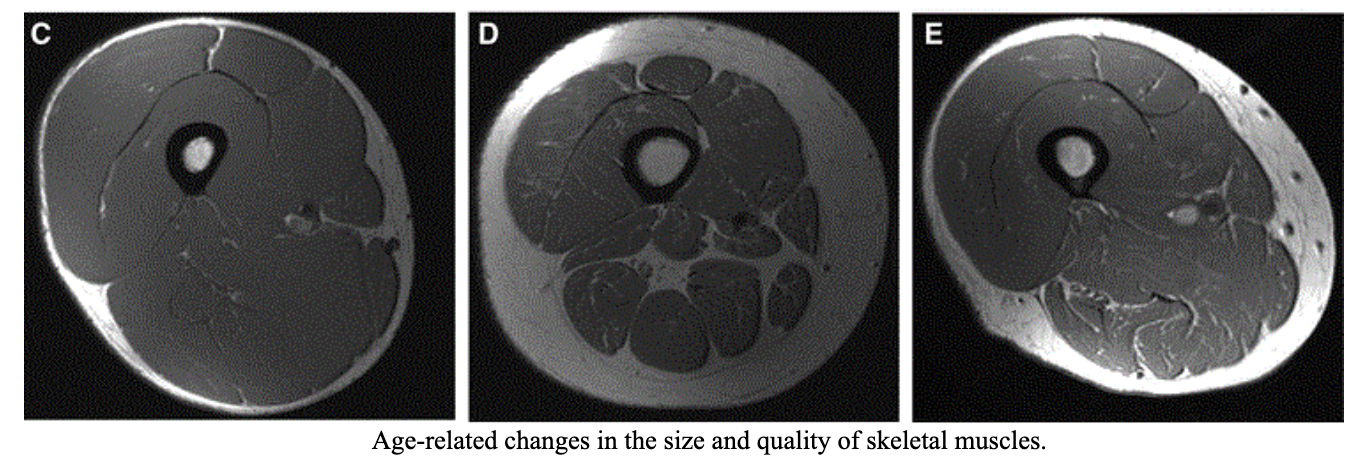Skeletal muscle accounts for about 40% of adult body weight. In addition to their primary functions (posture, movement, and breathing), skeletal muscles also store important nutrients and regulate metabolism.
As people age, they lose about 30% of their maximum muscle mass by the age of 80, a process exacerbated by the lack of exercise and malnutrition. We call this process sarcopenia. It results in lower basal metabolic rate, weakness, reduced activity levels, decreased bone density, and low calorie needs, and causes an increase in body fat related to hypertension and abnormal glucose tolerance.
The MRI images below show the composition of muscle tissue of a 24 y.o. (c), a sedentary 66 y.o. (d), and an active 66 y.o. (e).
As people age, they lose about 30% of their maximum muscle mass by the age of 80, a process exacerbated by the lack of exercise and malnutrition. We call this process sarcopenia. It results in lower basal metabolic rate, weakness, reduced activity levels, decreased bone density, and low calorie needs, and causes an increase in body fat related to hypertension and abnormal glucose tolerance.
The MRI images below show the composition of muscle tissue of a 24 y.o. (c), a sedentary 66 y.o. (d), and an active 66 y.o. (e).

A sedentary 66 y.o. takes 3,141 steps per day for a total of 22 minutes of physical activity, while an active 66 y.o. completes 12,445 steps per day making them active for 130 minutes a day.
Correlation between the level of physical activity and the size of skeletal muscles

As muscle mass decreases with age, more fat penetrates into muscle tissues, but physical activity enables one to retain more skeletal muscle in the process of aging.
The good news is that many consequences of sarcopenia are preventable or even reversible. Progressive resistance exercises can produce substantial increases in strength and muscle size, even among the elderly. Such exercises focus on large muscle groups throughout your whole body and involve participants exercising their muscles against some type of resistance that is progressively increased as their strength improves. Common examples include push-ups, wall sits, and walking on a treadmill.
Regular resistance exercise induces muscle hypertrophy due to a chronically elevated level of protein. Although older people with sarcopenia show age-related resistance to anabolism in response to exercise and protein intake, the cumulative effect of regular exercise and adequate protein intake still helps repair and maintain muscle.
The good news is that many consequences of sarcopenia are preventable or even reversible. Progressive resistance exercises can produce substantial increases in strength and muscle size, even among the elderly. Such exercises focus on large muscle groups throughout your whole body and involve participants exercising their muscles against some type of resistance that is progressively increased as their strength improves. Common examples include push-ups, wall sits, and walking on a treadmill.
Regular resistance exercise induces muscle hypertrophy due to a chronically elevated level of protein. Although older people with sarcopenia show age-related resistance to anabolism in response to exercise and protein intake, the cumulative effect of regular exercise and adequate protein intake still helps repair and maintain muscle.
An example of progressive resistance training program for older people

Abe Health is here to help you find a healthy balance at any stage of your life. Our AI-powered platform selects the right exercises and training load based on only a few parameters such as age, weight, health limitations, number of training days per week, and time for training. Based on the performance calculator, Abe calculates the training load in the form of exercises, weights, sets, and offers possible training methods and the database of appropriate exercises that are customized just for you.
References:
- Samsonova A.V. The hypertrophy of human skeletal muscle / A.V. Samsonova - Monograph, St. Petersburg, 2012. P.204
- Vlasova I.A. Biological age and level of health of older people involved in physical training. / I.A. Vlasova / Journal "Siberian Medical Journal". - 2011, - No. 5 - p.65-67
- Andrew C. Betik, Russell T. Hepple. NRS Research Press / Article «Determinants of VO2 max decline with aging: an integrated perspective», 2008. – с.744-752
- Andersen Jesper L. Scandinavian Journal Medicine and Science in Sport /Article «Muscle fibre type adaptation in the elderly human muscle», 2013. – с.40-47
- Boirie Y, Gachon P, Beaufrere B. American Journal Clinic Nutrition / Article «Splanchnic and whole-body leucine kinetics in young and elderly men», 1997 – с.489–495
- Brook MS, Wilkinson DJ, Phillips BE, Perez-Schindler J, Philp A, Smith K, Atherton PJ/ ACTA Physiologica. Article «Skeletal muscle homeostasis and plasticity in youth and ageing: impact of nutrition and exercise», 2015 – с.15-41
- Kuk JL, Saunders TJ, Davidson LE, Ross. Ageing Research Reviews/ Article «Age-related changes in total and regional fat distribution», 2009. – с.339-348
- Kumar V, Selby A, Rankin D, et al. Journal Physiology / Article «Age-related differences in the dose-response relationship of muscle protein synthesis to resistance exercise in young and old men», 2009. – с.211–217
- Kadi F, Charifi N, Denis C, Lexell J. Muscle & nerve / Article «Satellite cells and myonuclei in young and elderly women and men», 2004. – с.120-127
- Kortebein P., J Gerontol Ser A. American Journal of Physiology / Article «Functional impact of 10 days of bed rest in healthy older adults», 2008 – с1076–1081
- Leenders M, Verdijk LB, van der Hoeven L, van Kranenburg J, Nilwik R, van Loon LJ. The Journals of Gerontology. Article «Elderly men and women benefit equally from prolonged resistance-type exercise training», 2013 – с.769-779
- Lexell J. The Journals of Gerontology Series A Biological Sciences and Medical Sciences / Article «Human aging, muscle mass, and fiber type composition», 2005. – с.11-16
- Michael McLeod. Live strong and prosper: the importance of skeletal muscle strength for healthy ageing / Michael McLeod, Leigh Breen, D. Lee Hamilton, Andrew Philp / Article «Biogerontology», 2016. – с.497-510
- Macaluso A, De Vito G. European Journal of Applied Physiology / Article «Muscle strength, power and adaptations to resistance training in older people», 2004. – с.450-472
- Montero-Fernandez N, Serra-Rexach JA. Euroean journal of physical and rehabilitation medicine. Article «Role of exercise on sarcopenia in the elderly»», 2013 – с.131-143
- Mitchell WK, Williams J, Atherton P, Larvin M, Lund J, Narici M. Fronties in Physiology / Article «Sarcopenia, dynapenia, and the impact of advancing age on human skeletal muscle size and strength; a quantitative», 2012. – 260 C.
- Narici MV, Maganaris CN, Reeves ND, Capodaglio P. Journal of Applied Physiology / Article «Effect of aging on human muscle architecture», 2006. – с.222-234
- Pennings B, Koopman R, Beelen M, Senden JM, Saris WH, van Loon LJ. American Journal Clinic Nutrition / Article «Exercising before protein intake allows for greater use of dietary protein-derived amino acids for de novo muscle protein synthesis in both young and elderly men», 2011 – с. 322–331
- Ruiz JR, Sui X, Lobelo F, Morrow JR Jr, Jackson AW, Sjostrom M, Blair SN. The bmj / Article «Association between muscular strength and mortality in men: prospective cohort study», 2008 – с.337-439
- Schrager MA, Metter EJ, Simonsick E, Ble A, Bandinelli S, Lauretani F, Ferrucci L. European Journal of Applied Physiology / Article «Sarcopenic obesity and inflammation in the InCHIANTI study», 2007. – с.919-925.
- Stephens FB, Chee C, Wall BT, Murton AJ, Shannon CE, van Loon LJ, Tsintzas K. American Diabetes Assosiation / Article «Lipid-induced insulin resistance is associated with an impaired skeletal muscle protein synthetic response to amino acid ingestion in healthy young men», 2015. – с.1615-1620.
- Short KR, Vittone JL, Bigelow ML, Proctor DN, Nair KS. American Journal of Physiology / Article «Age and aerobic exercise training effects on whole body and muscle protein metabolism», 2004. – c. 92–101.
- Topinkova Eva. Aging, Disability and Frailty. Annals nutrition and metabolism / Article «Aging, Disability and Frailty», 2008. – с.6-11
- Timmerman KL, Dhanani S, Glynn EL, et al. American Journal Clinic Nutrition / Article «A moderate acute increase in physical activity enhances nutritive flow and the muscle protein anabolic response to mixed nutrient intake in older adults», 2012 – с. 1403–1412
